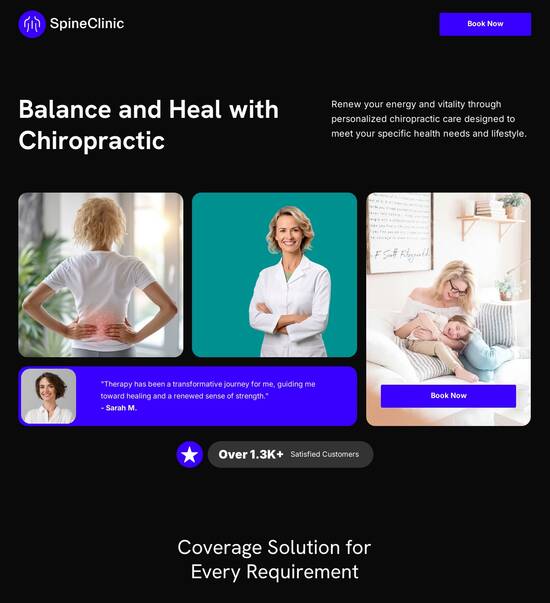
Onboarding page template for publishing companies
Explore Similar TemplatesAbout template
Reach out to the right audience with onboarding page template for publishing companies
Recommended templates

Easy to build without coding
With the intuitive drag-and-drop builder, anyone on your team can create high-converting pages without any knowledge of code or design. Make enhancements to your landing page with custom widgets using Javascript, HTML/CSS, or third-party scripts.

Multiple layouts for any industry and goal
Select from 500+ landing page layouts built to boost conversions across industry-specific scenarios. Customize them by adjusting fonts, adding images, and generating on-brand content with the AI assistant. Quickly scale with Instablocks® and Global Blocks that you can save, reuse, and update globally.

Loads fast and looks polished on any device
Every template is responsive, which means they present professionally on any device and load blazingly fast with our Thor Render Engine. You can also power them up with Google AMP technology to deliver an unparalleled mobile experience and drive higher conversions.

Robust analytics & experimentation
Get real-time updates and reporting across all your devices, showing the number of visitors, conversions, cost-per-visitor, and cost-per-lead. Launch AI-powered experiments, run A/B tests, and use heatmaps to analyze user behavior, then optimize your landing page to maximize conversions.







Easy to build without coding
With the intuitive drag-and-drop builder, anyone on your team can create high-converting pages without any knowledge of code or design. Make enhancements to your landing page with custom widgets using Javascript, HTML/CSS, or third-party scripts.
Multiple layouts for any industry and goal
Select from 500+ landing page layouts built to boost conversions across industry-specific scenarios. Customize them by adjusting fonts, adding images, and generating on-brand content with the AI assistant. Quickly scale with Instablocks® and Global Blocks that you can save, reuse, and update globally.
Loads fast and looks polished on any device
Every template is responsive, which means they present professionally on any device and load blazingly fast with our Thor Render Engine.
Robust analytics & experimentation
Get real-time updates and reporting across all your devices, showing the number of visitors, conversions, cost-per-visitor, and cost-per-lead. Launch AI-powered experiments, run A/B tests, and use heatmaps to analyze user behavior, then optimize your landing page to maximize conversions.
All the features you need to build lead-generating landing pages
Explore more featuresLearn how to build top-performing landing pages for any goal
FAQs
Leading the way in building high-performing landing pages





An ultimate guide to using Instapage for effective landing page creation
Creating high-converting landing pages is essential for marketers in various sectors such as business services, education, and financial services. With Instapage, you can leverage powerful tools designed specifically to enhance your campaigns. This guide will take you through step-by-step processes to maximize ROI using Instapage’s features.
Understanding the Instapage platform
Instapage is an all-in-one landing page and conversion rate optimization (CRO) platform that simplifies the creation of landing pages for marketers of all backgrounds. Its user-friendly interface allows you to design pages without the need for coding. Let’s explore how you can utilize Instapage's features effectively.
- Templates: Instapage provides access to over 100 high-converting templates, making it easy to choose a design that suits your campaign goals.
- Optimization Tools: Built-in A/B testing and analytics help you understand user behavior, allowing for continuous optimization.
- Collaboration Features: With real-time feedback and collaborative editing, teams can streamline the landing page creation process.
Step 1: Selecting the Best Template
Choosing the right landing page template can set the foundation for success. Move beyond aesthetics; consider templates that align with your audience's needs.
- Identify your audience: Focus on templates designed for your target sector, whether it's tech, education, or financial services.
- Aim for clarity: Select designs that present information clearly—less clutter can lead to higher conversions.
- Incorporate lead generation elements: Ensure the chosen template has spaces for forms and calls to action.
Step 2: Customizing and Personalizing Your Page
Personalization is key to increasing engagement on landing pages. Use Instapage to tailor content that resonates with your target audience.
- Dynamic Text Replacement: This allows you to align your messaging based on user demographics, making your offers more compelling.
- AdMaps Integration: Connect your marketing campaigns to your landing pages seamlessly, ensuring that the message remains consistent.
- Audience Tracking: Utilize analytics tools to monitor how different segments interact with your page for better targeting in the future.
Step 3: Optimizing and Testing
After launching your landing page, the work doesn’t stop. Use A/B testing to compare variations and heatmaps to analyze user behavior.
- Set clear goals: Determine what metrics you want to improve, such as conversion rates or engagement times.
- Conduct A/B tests: Regularly test headlines, images, and CTAs to see which performs better.
- Utilize analytics: Review performance data continuously to make informed adjustments to enhance your landing page.
By following these steps using Instapage, you're well on your way to creating landing pages that not only attract visitors but convert them into leads.
Start harnessing the power of Instapage today to elevate your marketing campaigns. Sign up for a free trial and see how it can transform your approach to landing page creation.
People also ask about Onboarding page template for publishing companies
Onboarding page template for publishing companies
Understanding the importance of an onboarding page template in publishing companies
Onboarding is a crucial process for any organization, serving as the bridge between the new hire and their future role within the company. In publishing companies, this process is particularly significant due to the unique industry dynamics. From understanding intricate workflows to adapting to a fast-paced environment, new employees face challenges that require a robust onboarding program.
The role of onboarding in publishing organizations encompasses educating new hires about company culture, policies, and operational workflows. However, publishing companies often grapple with high turnover rates and the need for specialized knowledge, which can complicate onboarding efforts. This is where an effective onboarding page template comes into play, helping streamline the integration of new staff and fostering productivity.
Clarification of roles and responsibilities
Facilitation of knowledge transfer
Promotion of team engagement and collaboration
When designed thoughtfully, an onboarding page can significantly enhance new employee integration. By minimizing redundancies and confusion, it allows new hires to acclimatize quickly, thereby boosting overall productivity and morale.
Key objectives of an effective onboarding page template
An onboarding page template serves multiple functions, primarily aimed at streamlining the onboarding process. First and foremost, it enhances HR efficiency by providing a centralized hub for resources, information, and task management. With a well-designed onboarding page, HR teams can easily track the progress of new hires and ensure that all necessary documentation is collected timely.
Additionally, an effective onboarding page ensures consistency in how company policies are communicated. This prevents miscommunication and helps establish a clear understanding of expectations between new employees and their managers. Interactive elements within the onboarding page can further improve engagement, allowing new hires to explore materials at their convenience while integrating feedback mechanisms to gauge understanding.
Central repository for onboarding materials
Consistent dissemination of company policies
Encouragement of new hire engagement through interactivity
Expedited transition to productivity
Essential components of an effective onboarding page template
The backbone of an effective onboarding page template revolves around essential information sections that guide the new hire through their initial days with the company. An employee information form is a critical starting point, where new hires fill out crucial details that are necessary for administrative purposes. This form should collect information such as contact details, tax information, and emergency contacts to ensure that all relevant details are up-to-date from the beginning.
Furthermore, onboarding documents should be readily accessible within the template. This includes contracts, tax forms, benefits information, and any other paperwork new hires may need to complete.Centralizing these documents in the onboarding page not only facilitates ease of access but also ensures that new hires don't miss out on any critical paperwork. Easy navigation and availability of these documents lead to a smoother onboarding experience.
Employee information form for documentation
Access to relevant onboarding documents
Clear instructions for completing required forms
Guided onboarding process
An effective onboarding process not only begins on the first day but can extend beyond that through structured preboarding activities. A preboarding checklist is an excellent tool that ensures that new hires are prepared before their first official day. Items on this checklist might include logistics related to equipment (like tech setup) and scheduling introductions with team members across departments.
Following the initial preparations, a step-by-step onboarding plan ensures that new hires know what to expect on their first day. This should include welcoming activities, introductions to company culture, and an overview of company policies. Beyond Day 1 orientation, a timeline detailing milestones over the first few months can help newly onboarded employees track their progress while also facilitating networking opportunities across departments.
Preboarding checklist for early preparation
Structured activities for Day 1
Milestone tracking post-onboarding
Opportunities for cross-departmental networking
Customizing the onboarding experience
To maximize the onboarding experience, it’s essential to tailor content to suit different roles within the publishing company. While some information will be universal, each department may have specific processes or tools that require focused onboarding. Templates should allow for departmental customization, ensuring new hires receive targeted guidance relevant to their position and discipline.
Role-focused quizzes and activities can also enhance the onboarding experience by reinforcing expectations and familiarity with company culture. Incorporating interactive components into this section encourages new hires to engage directly with their responsibilities, which leads to a more profound understanding and quicker acclimatization to their roles.
Role-specific content and resources
Department-specific onboarding experiences
Interactive quizzes reinforcing expectations
Incorporating company policies
Integrating relevant company policies into the onboarding page is crucial for setting clear expectations. New hires should have easy access to a comprehensive overview of the key policies they need to understand, from workplace conduct to data protection guidelines. Presenting this information engagingly helps reinforce the organizational culture while making it easier for new hires to absorb.
Utilizing innovative formats such as videos, infographics, and interactive elements can make policy information not only more engaging but also easier to remember. Additionally, as company policies evolve, the onboarding template should be designed to incorporate updates seamlessly, ensuring that new hires are always equipped with the most recent information.
Comprehensive policy overviews
Multimedia presentation of policy documents
Regular updates for accurate information
Enhancing engagement and retention through design
User-centric design is essential in crafting an effective onboarding page template. Intuitive navigation fosters a smoother experience, allowing new hires to find essential information quickly. Incorporating visual assets, such as infographics and videos, enriches the onboarding experience and helps new hires engage more meaningfully with the content presented to them.
Personalization features also play a vital role in enhancing the onboarding experience. Addressing new hires by name and including role-specific mentors can foster a sense of connection and make new employees feel valued as they transition into their roles. Interactive features like quizzes and feedback loops not only assess understanding but also create a culture of continuous improvement throughout the onboarding process.
User-friendly and intuitive navigation
Use of multimedia for deeper engagement
Personalized interactions for new hires
Streamlining HR workflows with technology
Utilizing technology to automate onboarding processes greatly benefits publishing companies. Automation tools can manage document collection, task tracking, and workflow management, freeing up HR teams to focus on more strategic initiatives. Software integration with other HR systems such as payroll and communication platforms enhances efficiency, reducing the likelihood of errors associated with manual processes.
Data-driven insights play a pivotal role in measuring the success of onboarding efforts. Analyzing feedback and completion rates can highlight areas that need improvement, informing future updates for the onboarding template. Ultimately, successful onboarding not only leads to reduced turnover rates but also boosts employee satisfaction, creating a more engaged workforce.
Benefits of implementing automation tools
Integration with existing HR systems
Utilizing analytics for future improvements
Best practices for implementing an onboarding page template
When creating or refining an onboarding page template, assessing the company's needs is paramount. Key questions to consider include: What specific information do new hires require? What resources are currently lacking? Understanding these elements can guide the design process and ensure it meets the needs of both the HR department and new employees.
Involving current employees in the design process can yield valuable insights. They can offer firsthand experiences and suggest improvements, ensuring that the onboarding page is practical and user-friendly. Establishing a continuous improvement strategy through regular feedback from new hires will further solidify this approach, making certain that onboarding remains relevant and effective over time.
Assessing company-specific onboarding needs
Involving current employees in the template design
Implementing continuous feedback for improvement
The future of onboarding in publishing companies
The future of onboarding holds exciting possibilities, particularly with emerging trends like virtual and augmented reality. These tools can provide immersive training experiences that allow new hires to familiarize themselves with complex workflows in real-time scenarios. Adapting onboarding templates for remote workforces also emphasizes the need for flexible, online-friendly content that can be accessible to all employees, regardless of their location.
Investing in a robust onboarding page template not only enhances organizational culture through informed employees but also equips new hires with the tools to succeed in a constantly evolving publishing landscape. Focusing on the long-term benefits of thoughtful onboarding practices encourages employee loyalty, satisfaction, and effectiveness, ultimately supporting the broader goals of the publishing organization.
Incorporation of VR and AR in training processes
Adaptations for remote onboarding
Long-term investment for enhanced company culture
Ready to skyrocket conversions?
Supercharge your ad campaigns with high-performing landing pages
Get started














